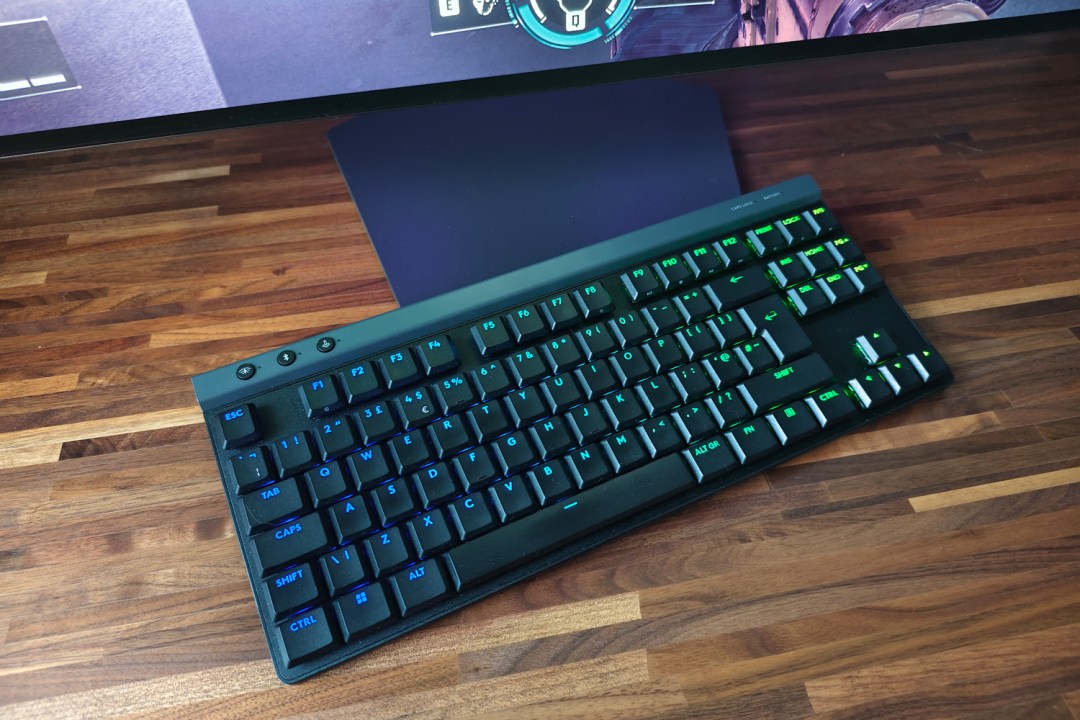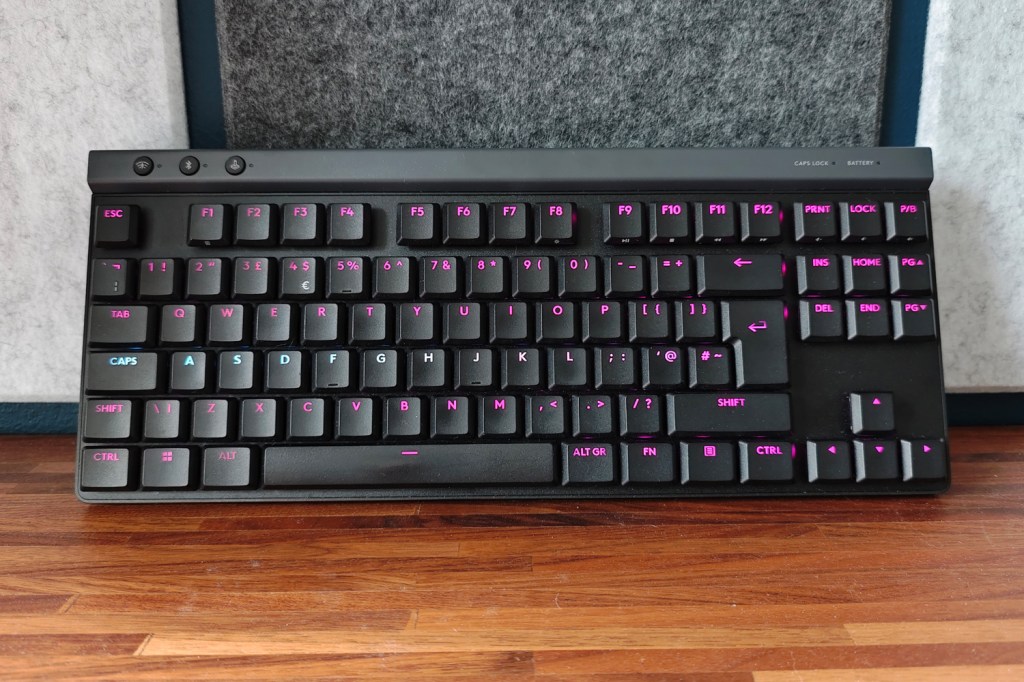Logitech G515 Lightspeed TKL review: low-profile goes more mainstream
A simpler, cheaper successor to the best low-profile gaming keyboard

Stuff Verdict
A well-built and responsive gaming keyboard that fixes many of the old G915 TKL’s flaws. The Logitech G515 Lightspeed TKL makes some cutbacks, but gets two things spot on: performance and price.
Pros
- Sturdy construction and wear-resistant key caps
- Unflappable connectivity
- More affordable than low-profile wireless rivals
Cons
- Fewer features than the model it ‘replaces’
- Battery life could be better
Introduction
Low-profile gaming keyboards just don’t come along all that often. It’s been five years since Logitech’s previous effort, the G915 Lightspeed, earned a place in front of my gaming laptop, and nothing else I’ve tried has matched its mix of long battery life, flawless wireless connection and satisfyingly slim mechanical switches. But there’s definitely room for improvement. The new G515 Lightspeed TKL aims to address the G915’s flaws and out-of-date features, while also slashing the price.
This $140/£140 wireless ‘board is significantly easier on the wallet than the G915 was in its prime, yet tops it with uprated key switches and harder-wearing key caps. Micro-USB charging has finally been put out to pasture, and connectivity options are top tier. Logitech has had to make a few cutbacks to keep the price down, though. Is there enough here to lure gamers away from low-profile rivals – which while still small fry, have been steadily improving over the half-decade since the G915 first set the bar?
How we test keyboards
Every keyboard reviewed on Stuff is put through its paces for both typing and PC gaming. We use our years of testing experience to judge build quality, software experience, lighting effects and other features. Manufacturers have no visibility on reviews before they appear online, and we never accept payment to feature products.
Find out more about how we test and rate products.
Design & build: simpler (for the better)






This might be a tenkeyless (TKL) board with no number pad and an incredibly slim 22mm profile, but the G515 Lightspeed has some serious heft to it. At 880g it’s actually heavier than the G915, and stayed rooted in place once I placed it on my desk. That weight is surprising, as Logitech has gone for an all-plastic chassis and has stripped away the G915’s dedicated media controls. I really missed that board’s volume roller; the FN shortcut commands used here aren’t nearly as satisfying, and it looks like there’s space at the top for media keys. Perhaps Logitech is saving that for a possible G915 MkII.
You can pick up a G515 in either black or white, but both have the same grey bottom plate that pokes out the top of the board. It’s where you’ll find the connectivity keys and Game mode button, power switch and USB-C charging port. The latter will be a godsend to anyone upgrading from a G915 – that keyboard was literally one of the last gadgets in my house that still used micro-USB.
There might be no number pad but the G515 still uses full-size keys. Most low-profile rivals are 65% or smaller keyboards, which not everyone will gel with. I prefer the full-size TKL layout, which keeps the arrow and navigation keys in a familiar position.
The key caps are made from doubleshot PBT plastic, with a slightly textured finish. This is much more hard-wearing than the ABS plastic Logitech used for the G915, which should mean they won’t fade or rub off nearly as quickly. I’ll be sure to report back if I spot any early signs of wear. They wobble a lot less now, too – though there’s still a bit of it here.
Underneath, the G915’s hook-style key switches have been replaced with cross-style ones. These are far more common, and a lot easier to remove, so third-party replacements will actually be possible without DIY surgery this time around.
I like that Logitech includes a little stash in the underside of the keyboard for the USB-A wireless receiver, and the two-stage feet give the keyboard a comfortable amount of elevation. You don’t get a travel case like Logitech includes with the G Pro X 60, but that’s not a huge deal here as the G515 isn’t exclusively aimed at travelling gamers. There’s no wrist rest, either – detachable or otherwise.
Features & software: faster than light



You’re giving up nothing in terms of input delay by using the G515’s included wireless dongle, as Logitech’s Lightspeed tech is basically zero latency. If you’ve got one of the firm’s mice (a compatible one, anyway) you can even piggyback off it, freeing up one of your PC’s USB ports. I had a perfect wireless connection even when I moved my gaming laptop into the next room, and couldn’t tell any difference in response times compared to being connected over USB-C. You can also connect via Bluetooth, which is particularly handy for gaming handhelds like the Steam Deck.
Naturally you get full per-key RGB backlighting, with consistent illumination across the entire board. There are only two exceptions where symbols have been etched into the cap, which is only an issue if you work in total darkness and regularly struggle to find the Euro symbol. Logitech’s G Hub software has a bunch of preset lighting effects to choose from, a freestyle editor that gets properly granular if you have the time, and the much easier option of downloading community-made effects.
If you insist on full brightness backlighting, expect the G515 Lightspeed to be out of juice in around 36 hours. That’s comfortably four or five days of working hours, or several marathon gaming sessions, and dialling down the brightness (or switching off the RGB altogether) can extend a full charge to as much as 600 hours of use. This is behind Logitech’s other recent efforts, although those were much thicker and had more space inside for batteries. As low profile boards go, it’s a respectable effort.
G Hub’s latest addition is Keycontrol, a multi-layer macro tool that first landed with the G Pro X 60. You can effectively give every single key up to fifteen different functions, which I’m sure even the most hardcore MMO player will agree is a little over the top. It’s simple enough to set up a few critical key binds, though, and only have them active in certain games. If you’re worried about a lack of dedicated shortcut keys, this should put your mind at ease.
Performance: switch it up



Logitech sells the G515 Lightspeed TKL with either tactile brown key switches, or linear red ones. My review unit came with the former. I’m a big fan of the tangible bump you get with each keystroke, even if you have to apply a little more force (45g vs 43g for the red switches – though both are less than the 50g needed for the G915).
Each have the same 1.3mm actuation point, which is shorter than the G915, and in theory makes them even quicker than a full-profile Cherry MX switch. Ultimately it made no difference to my typing speed or gaming prowess. 3.2mm of total travel is pretty decent, too. It meant I rarely bottomed out while typing.
One of the biggest reasons for going low-profile is the sound. The G515 is a lot quieter than a regular mechanical keyboard, thanks partly to the switch design, but also because Logitech has pre-lubed them from the factory and added a layer of sound-dampening foam inside the keyboard chassis. The only way to get a more satisfying click would be to buy from a boutique keyboard brand, which will likely cost a whole lot more than this.
Logitech G515 Lightspeed TKL verdict

The G515 Lightspeed TKL isn’t the perfect replacement for the G915 – but it fixes the biggest issues I had with that keyboard. I’m confident the keycaps won’t wear nearly as quickly, and if they do they’ll be far easier to replace; the switches are even more satisfying to type on now, and with less wobble; and the software customisation means I can go mad with macros if I want. The plastic construction, shorter battery life and lack of multimedia keys are small prices to pay for that.
Some gamers might feel otherwise. Low-profile alternatives are few and far between, and none are as affordable as the G515, but an Asus ROG Falchion RX Low Profile isn’t a ridiculous amount more.
Stuff Says…
A well-built and responsive gaming keyboard that fixes many of the old G915 TKL’s flaws. The Logitech G515 Lightspeed TKL makes some cutbacks, but gets two things spot on: performance and price.
Pros
Sturdy construction and wear-resistant key caps
Unflappable connectivity
More affordable than low-profile wireless rivals
Cons
Bad stuff 1
Bad stuff 2
Logitech G515 Lightspeed TKL technical specifications
| Keyboard style | Tenkeyless (TKL) |
| Switch type | Logitech GL (mechanical, low-profile) |
| Connectivity | USB-C, 2.4GHz wireless, Bluetooth |
| Battery life | 36 hours (RGB lighting on) 600 hours (lighting off) |
| Dimensions | 368x150x22mm, 880g |



